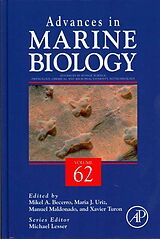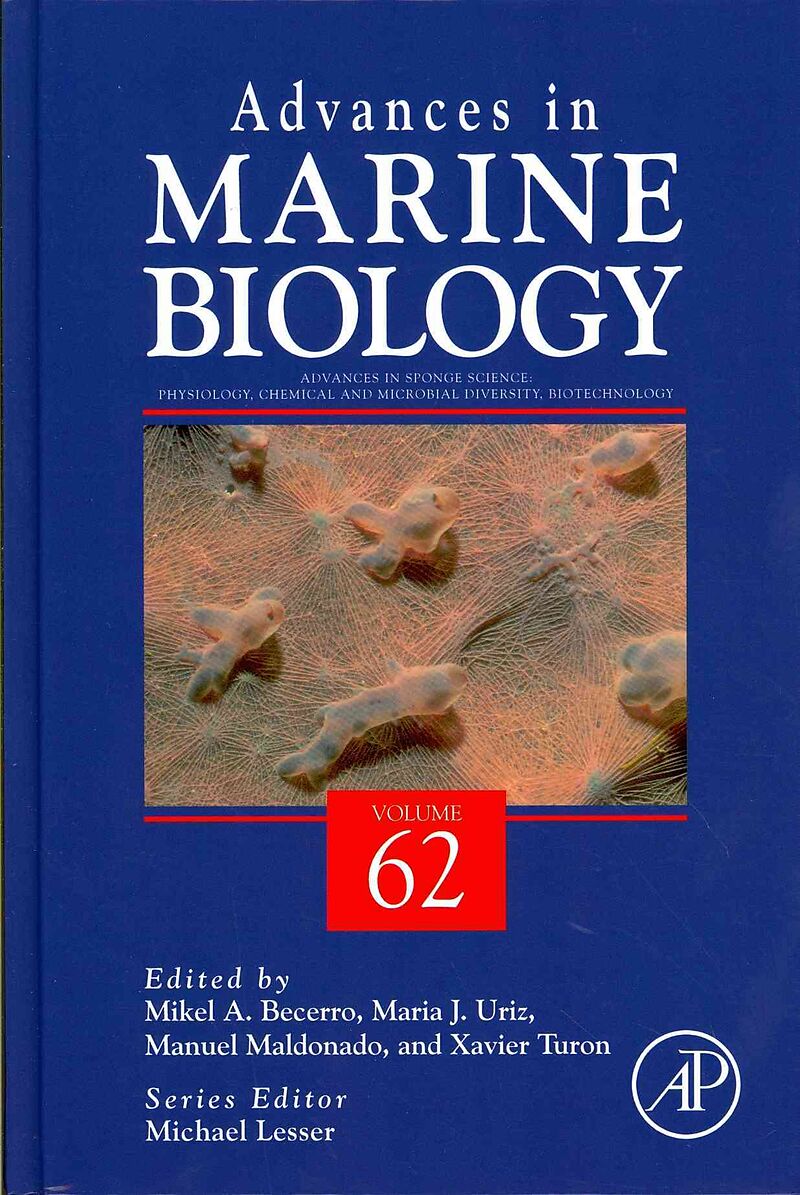Advances in Sponge Science: Physiology, Chemical and Microbial Diversity, Biotechnology
Einband:
Fester Einband
EAN:
9780123942838
Autor:
Michael (EDT) Lesser
Herausgeber:
Elsevier Science & Technology
Informationen zum Autor Educational Background Ph. D., University of Maine, Zoology, 1989 M.S., University of New Hampshire, Microbiology, 1985 B.A., University of New Hampshire, Microbiology, Minor: Zoology, 1983 A.S. George Washington University, Medical Laboratory Science, 1977 Courses Taught Biological Oceanography, Physiological Ecology, Marine Biology, Marine Microbiology, General Microbiology, Immunology, Biology and Ecology of Coral Reefs Current Research Interests My principal focus involve understanding how taxonomically diverse marine organisms respond physiologically to changes in their environment. In particular I'm interested in how organismal physiology can influence the ecology of marine organisms. As a physiological ecologist my students and I answer these types of questions by utilizing field and laboratory experiments, as well as a wide range of techniques from molecular biology to in situ measurements. Currently my research encompasses four major areas; 1) Biochemistry and molecular genetics of oxidative stress in marine organisms associated with exposure to ultraviolet radiation, elevated temperatures, or hyperoxic conditions. 2) Physiological ecology of marine invertebrates and phytoplankton, physiological responses to changes in the environment, bacterial- and algal-invertebrate symbioses, and the trophic biology of suspension-feeding invertebrates. 3) Ecology and photobiology of mesophotic coral reefs. 4) Underwater technology, use of technical diving for scientific research. Klappentext One of two special issues of Advances in Marine Biology focusing on sponge science, it features comprehensive reviews of the latest studies that are advancing our understanding of the fascinating marine phylum Porifera. The selected contributors are internationally renowned researchers in their respective fields and provide a thorough overview of the state-of-the-art of sponge science. Inhaltsverzeichnis 1- The physiology and molecular biology of sponge tissues Sally P. Leys and April Hill 2- Sponge-microbe symbioses: recent advances and new directions Robert W. Thacker and Christopher J. Freeman 3- Nutrient fluxes through sponges: biology, budgets, and ecological implications Manuel Maldonado, Marta Ribes and Fleur C. van Duyl 4- Sponge chemical diversity: from biosynthetic pathways to ecological roles Gregory Genta-Jouve and Olivier P. Thomas 5- Biosilica: molecular biology, biochemistry and function in demosponges as well as its applied aspects for tissue engineering Xiaohong Wang, Heinz C. Schröder, Matthias Wiens, Ute Schloßmacher and Werner E.G. Müller 6- Cultivation of sponges, sponge cells and symbionts: achievements and future prospects Klaske J. Schippers, Detmer Sipkema, Ronald Osinga, Hauke Smidt, Shirley A. Pomponi, Dirk E. Martens and Rene H. Wijffels ...
Autorentext
Educational BackgroundPh. D., University of Maine, Zoology, 1989M.S., University of New Hampshire, Microbiology, 1985B.A., University of New Hampshire, Microbiology, Minor: Zoology, 1983A.S. George Washington University, Medical Laboratory Science, 1977Courses TaughtBiological Oceanography, Physiological Ecology, Marine Biology, Marine Microbiology, General Microbiology, Immunology, Biology and Ecology of Coral ReefsCurrent Research InterestsMy principal focus involve understanding how taxonomically diverse marine organisms respond physiologically to changes in their environment. In particular I'm interested in how organismal physiology can influence the ecology of marine organisms. As a physiological ecologist my students and I answer these types of questions by utilizing field and laboratory experiments, as well as a wide range of techniques from molecular biology to in situ measurements. Currently my research encompasses four major areas;1) Biochemistry and molecular genetics of oxidative stress in marine organisms associated with exposure to ultraviolet radiation, elevated temperatures, or hyperoxic conditions. 2) Physiological ecology of marine invertebrates and phytoplankton, physiological responses to changes in the environment, bacterial- and algal-invertebrate symbioses, and the trophic biology of suspension-feeding invertebrates.3) Ecology and photobiology of mesophotic coral reefs.4) Underwater technology, use of technical diving for scientific research.
Klappentext
One of two special issues of Advances in Marine Biology focusing on sponge science, it features comprehensive reviews of the latest studies that are advancing our understanding of the fascinating marine phylum Porifera. The selected contributors are internationally renowned researchers in their respective fields and provide a thorough overview of the state-of-the-art of sponge science.
Zusammenfassung
Intends to marine biologists with interest in benthic ecology and biotic interactions, including symbiosis chemical and molecular ecology systematics, phylogeny, and evolution sponge culture and tissue engineering.
Inhalt
1- The physiology and molecular biology of sponge tissues Sally P. Leys and April Hill 2- Sponge-microbe symbioses: recent advances and new directions Robert W. Thacker and Christopher J. Freeman 3- Nutrient fluxes through sponges: biology, budgets, and ecological implications Manuel Maldonado, Marta Ribes and Fleur C. van Duyl 4- Sponge chemical diversity: from biosynthetic pathways to ecological roles Gregory Genta-Jouve and Olivier P. Thomas 5- Biosilica: molecular biology, biochemistry and function in demosponges as well as its applied aspects for tissue engineering Xiaohong Wang, Heinz C. Schröder, Matthias Wiens, Ute Schloßmacher and Werner E.G. Müller 6- Cultivation of sponges, sponge cells and symbionts: achievements and future prospects Klaske J. Schippers, Detmer Sipkema, Ronald Osinga, Hauke Smidt, Shirley A. Pomponi, Dirk E. Martens and Rene H. Wijffels

Leider konnten wir für diesen Artikel keine Preise ermitteln ...
billigbuch.ch sucht jetzt für Sie die besten Angebote ...
Die aktuellen Verkaufspreise von 6 Onlineshops werden in Realtime abgefragt.
Sie können das gewünschte Produkt anschliessend direkt beim Anbieter Ihrer Wahl bestellen.
Loading...
Die aktuellen Verkaufspreise von 6 Onlineshops werden in Realtime abgefragt.
Sie können das gewünschte Produkt anschliessend direkt beim Anbieter Ihrer Wahl bestellen.
| # | Onlineshop | Preis CHF | Versand CHF | Total CHF | ||
|---|---|---|---|---|---|---|
| 1 | Seller | 0.00 | 0.00 | 0.00 |
